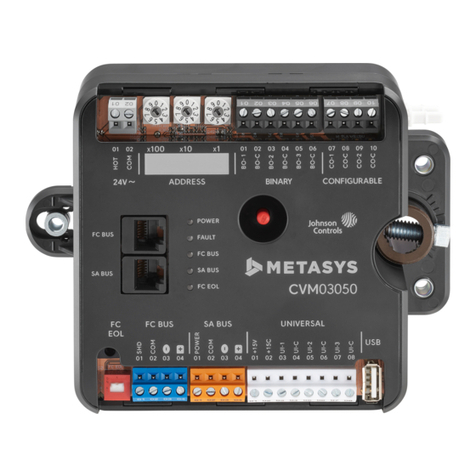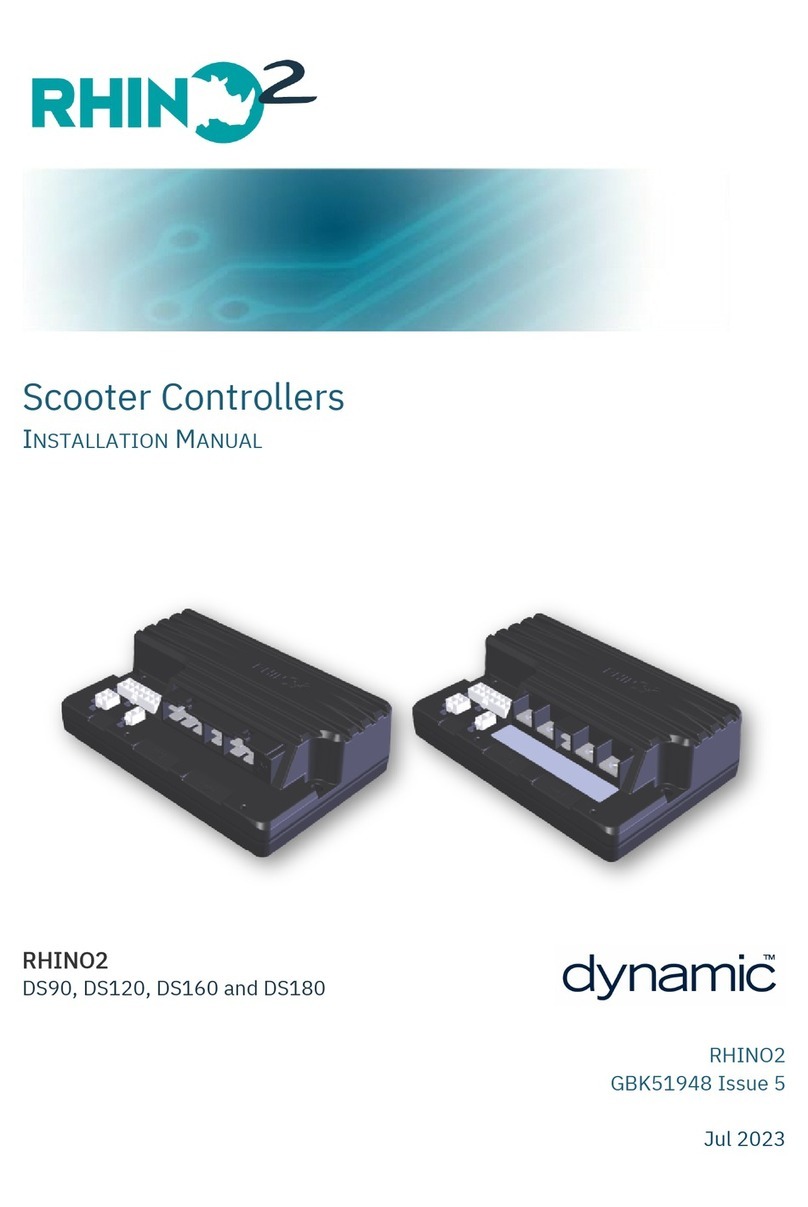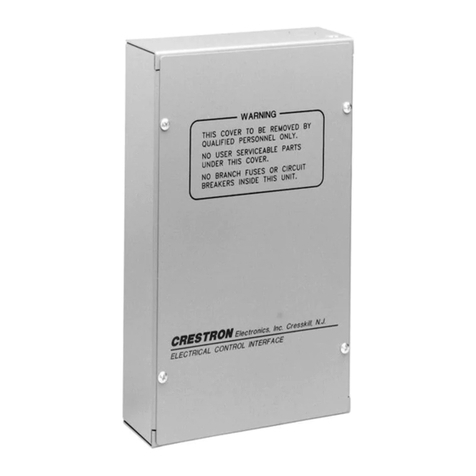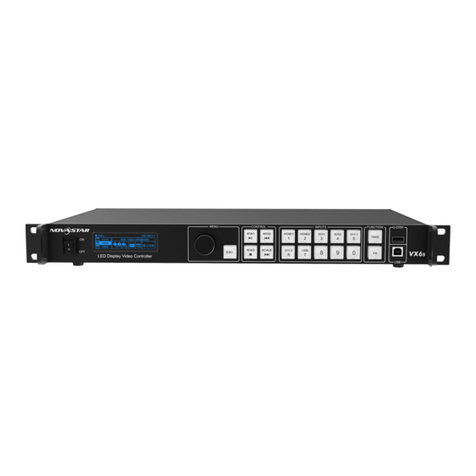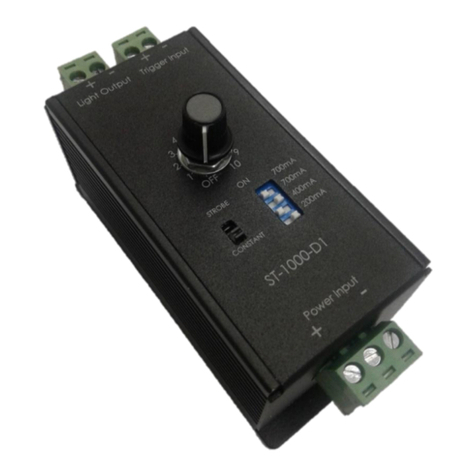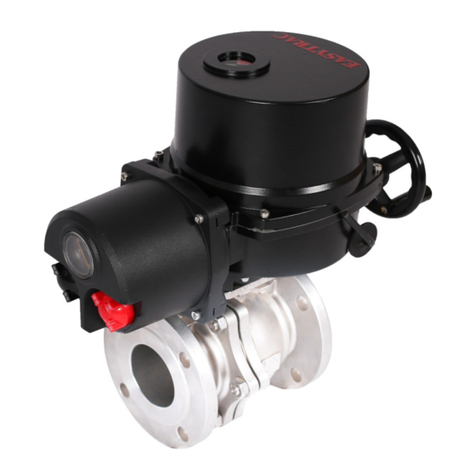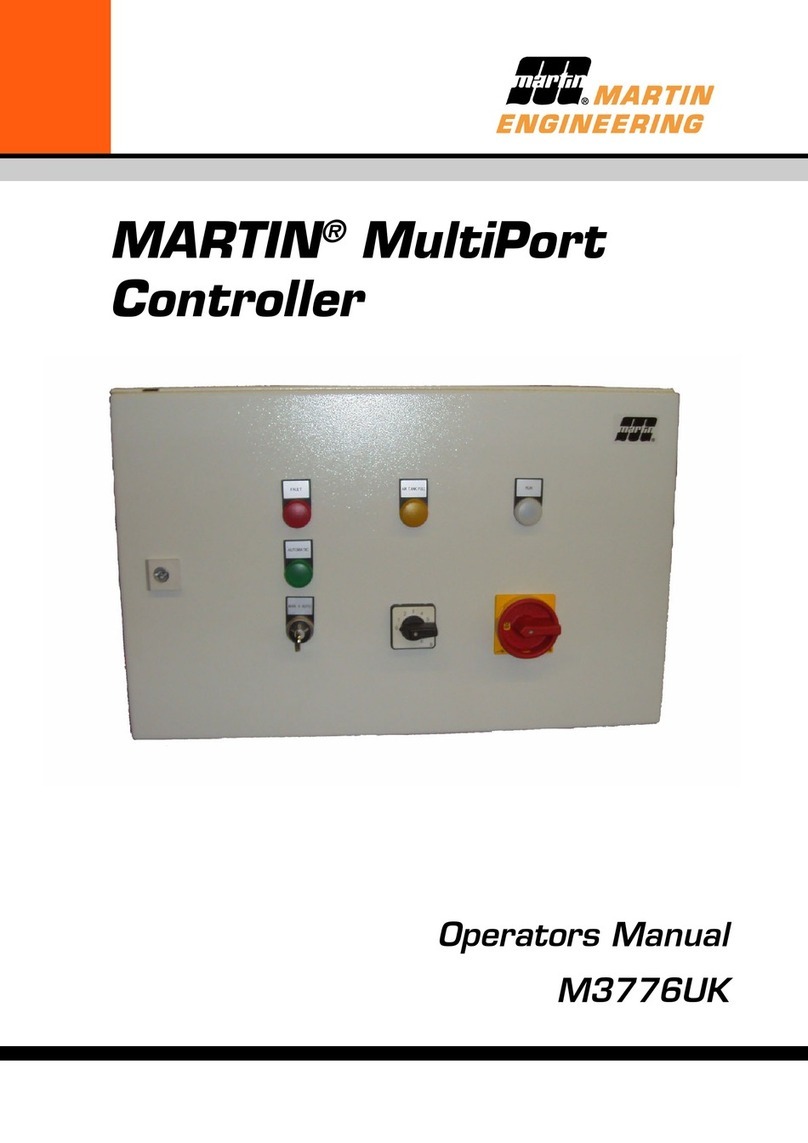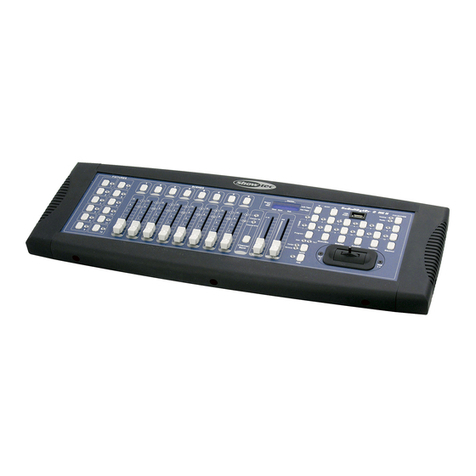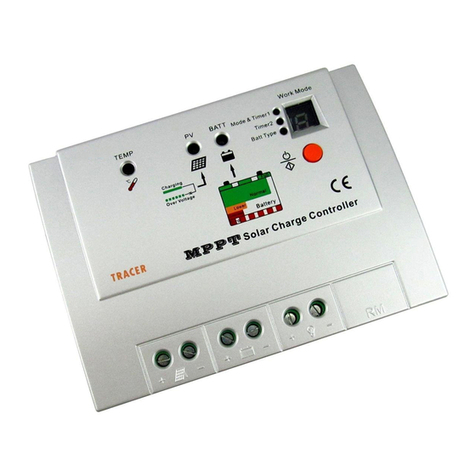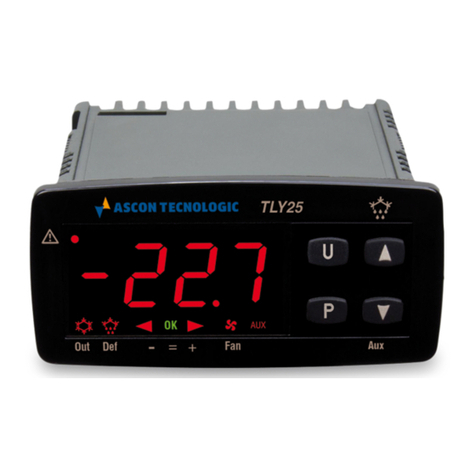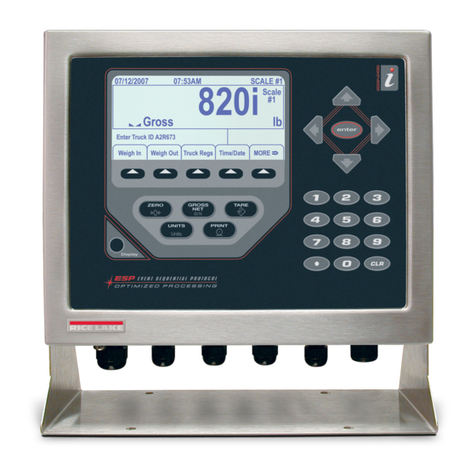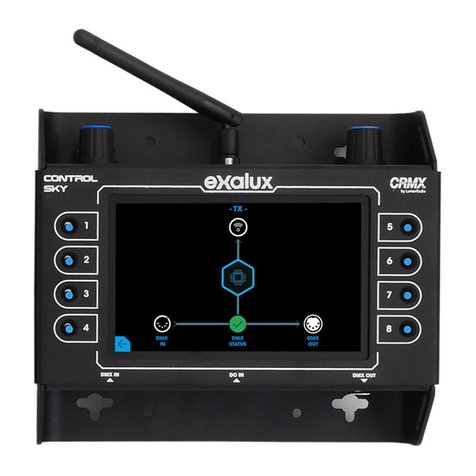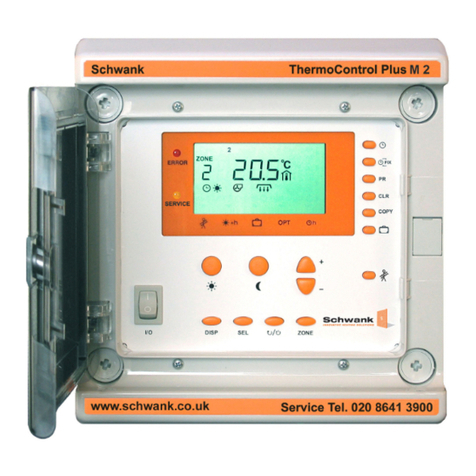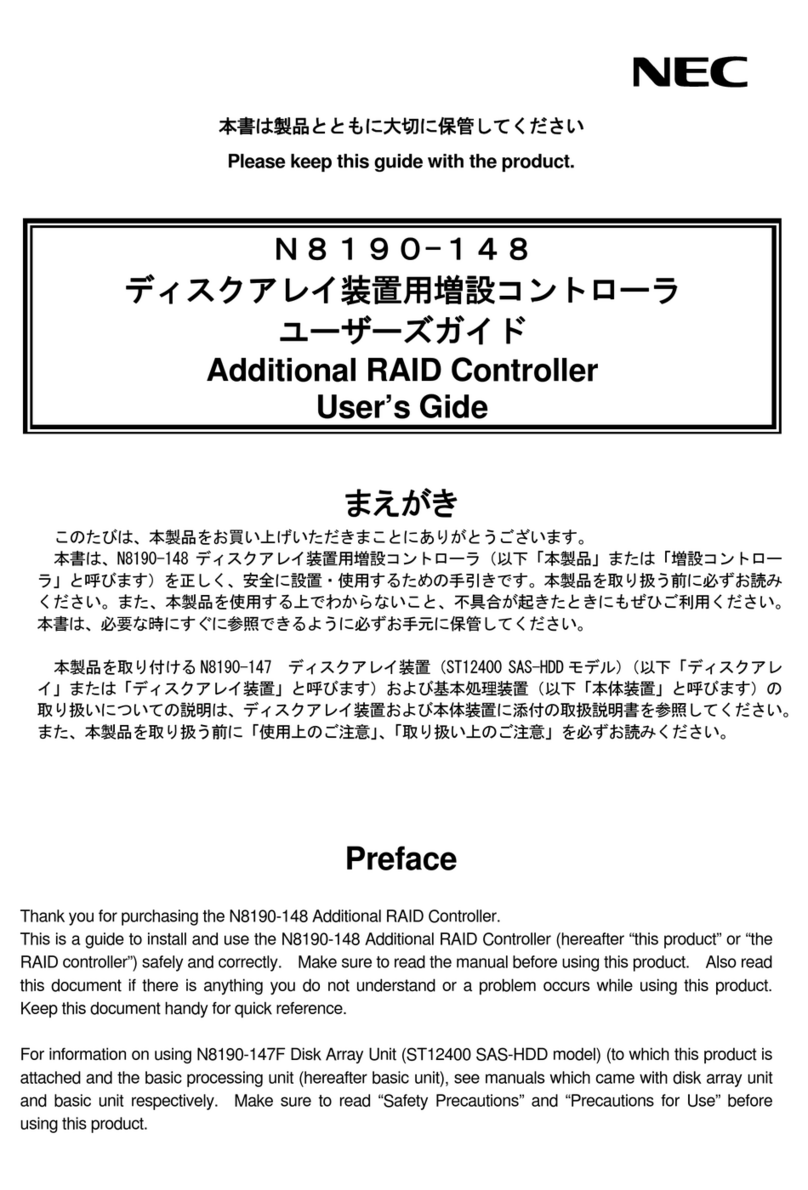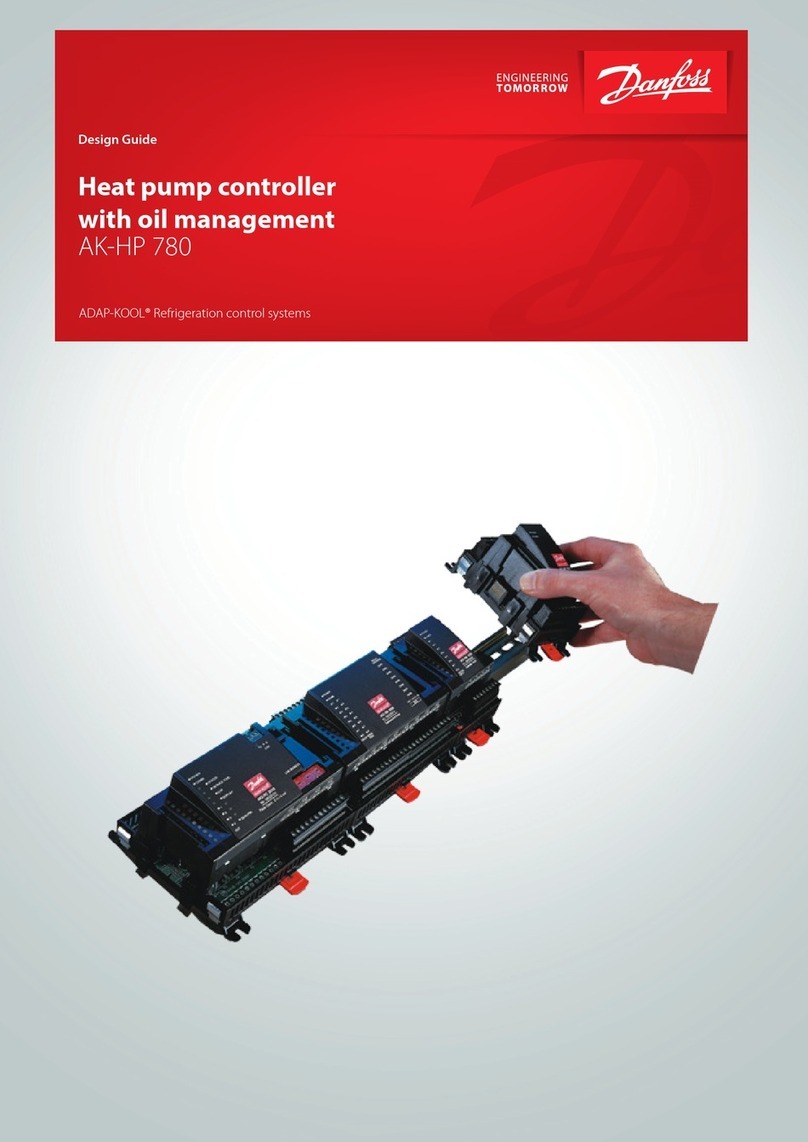Sno-Way PROCONTROL 99100993 Operating instructions

97101382D
INSTALLATION &
OWNER’S MANUAL
PROCONTROLTM OPERATING
SYSTEM PACKAGE
99100993, 99100994
Sno-Way®, Down Pressure® and EIS®are registered trademarks of Sno-Way International, Inc.
ProControl™, MegaBlade™, V-Wing™, E-Z Switch™, Revolution™, MaxAdjust™, SpeedLock™, and QuickJack™
are trademarks of Sno-Way International, Inc.
©2011 Sno-Way®International
HINWEIS: Deutsch beginnt auf Seite 17
MERK: Norsk begynner på side 33

2
TABLE OF CONTENTS
Page
INTRODUCTION ......................................................................................................... 3
SAFETY ...................................................................................................................... 4
FCC STATEMENT OF CONDITIONS ......................................................................... 5
INSTALLATION........................................................................................................... 6
Receiver Installation on Plow Power Pack..................................................... 6
Programming Receiver to Learn
Transmitter Code (Wireless ProControlTM) ................................................ 6
Control Harness Installation (Hard-Wired ProControl™).............................. 7
OPERATION................................................................................................................ 9
Theory of Operation .......................................................................................... 9
ProControl™ Operation - Basic Functions...................................................... 9
ProControl™ Operation - Extended Functions..............................................11
Programming a Macro.................................................................................11
Common Macro Programming ...................................................................11
Programming the Clock ............................................................................. 12
Auxiliary Functions .................................................................................... 12
Remaining Buttons..................................................................................... 12
Start/Stop Procedure for ProControl™ Transmitters .............................. 12
Power Saving Mode.................................................................................... 12
Diagnostic Functions ................................................................................. 12
ProControl™ Charging / Battery Maintenance and Replacement............... 13
ProControl™ Transmitter Mounting Instructions ......................................... 13
Using the ProControl™ to Aid in Mounting the Snow Plow ........................ 14
Storage (Hard-wired ProControl™)................................................................ 14
ProControl™ Battery Warranty....................................................................... 14

3
This manual was written for the assembly, installation and
maintenance of your new Sno-Way ProControlTM
Operating System. Most importantly, this manual provides
an operating plan for safe use. Refer to the Table of
Contents for an outline of this manual.
Please keep this manual with your machine at all times as
reference material and so it can be passed on to the next
owner if the machine is sold.
We require that you read and understand the contents of
this manual COMPLETELY, especially the chapter on
SAFETY, before attempting any procedure contained in
this manual.
The Society of Automotive Engineers has adopted
this SAFETY ALERT SYMBOL to pinpoint character-
istics that, if NOT carefully followed, can create a
safety hazard. When you see this symbol in this man-
ual or on the machine itself, BE ALERT!, your per-
sonal safety and the safety of others, is involved.
• Defined below are the SAFETY ALERT messages
and how they will appear in this manual.
NOTE: Additional information concerning the equipment
or the procedure that may or may not be contained else-
where in this manual.
NOTE: The wireless ProControl has a rechargable bat-
tery that may have little to no charge when unpackaged.
Upon installation, the battery must be fully charged
before the ProControl will be able to be paired to the
receiver on the plow. It may take 3 to 4 hours to charge
the battery in the controller. The LCD screen will display
"CHARGED" when the battery is fully charged. The Pro-
Control battery will not charge if the temperature is below
0° C (32° F).
BE AWARE! It is illegal to remove, deface or other-
wise alter the safety decals mounted on this equip-
ment.
Record the ProControlTM transmitter and Receiver Serial
Numbers. This is information that your Dealer needs to
answer questions or to order replacement parts, if
needed, for your unit.
We reserve the right to make changes or improve the
design or construction of any part(s) without incurring the
obligation to install such parts or make any changes on
any unit previously delivered.
cWARNING
FAILURE TO FOLLOW CAN RESULT IN INJURY
OR DEATH.
cCAUTION
Information, that if not carefully followed, can
cause injury or damage to equipment!
DEALER
NAME
PHONE ( ) –
ADDRESS
CITY STATE ZIP
(FILL IN)
ORIGINAL PURCHASER
NAME
PHONE ( ) –
ADDRESS
CITY STATE ZIP
(FILL IN)
NAME PLATE DATA
(FILL IN)
PROCONTROLTM SERIAL NUMBERS:
TRANSMITTER S.N.
RECEIVER S.N.
Snow-Way Products are built under one or more of the
following patents:
5,524,368
6,691,435
6,860,039
5,832,637
6,701,646
6,860,040
5,894,688
6,702,208
2,121,948 5,987,785
6,775,933
6,154,986
6,778,932 7,137,724
7,171,769
7,146,754
7,171,770 7,640,682
INTRODUCTION

4
BEFORE ATTEMPTING ANY PROCEDURE IN THIS
BOOK, READ AND UNDERSTAND ALL THE SAFETY
INFORMATION CONTAINED IN THIS SECTION. IN
ADDITION, ENSURE ALL INDIVIDUALS WORKING
WITH YOU ARE ALSO FAMILIAR WITH THESE
SAFETY PRECAUTIONS.
For your safety Warning and Information Decals have
been placed on this product to remind the operator
to take safety precautions. It is important that these
decals are in place and are legible before operation
begins. New decals can be obtained from Sno-Way or
your local dealer.
REMEMBER The careful operator is the best
operator. Most accidents are caused by human error.
Certain precautions must be observed to prevent the
possibility of injury to operator or bystanders and/or
damage to equipment.
NEVER operate Plow when under the influence of
alcohol, drugs or other medications that could hamper
your judgement and reactions. An accident may result in
serious injury or death to other persons or yourself.
ALWAYS operate vehicle in a well-ventilated area. The
carbon monoxide in exhaust gas is highly toxic and can
cause serious injury or death.
NEVER allow hands, hair or clothing to get near any
moving parts such as fan blades, belts and pulleys.
Never wear neckties or loose clothing when working on
the vehicle.
NEVER wear wrist watches, rings or other jewelry when
working on the vehicle or individual equipment. These
things can catch on moving parts or cause an electrical
short circuit that could result in serious personal injury.
ALWAYS wear safety goggles when working on the
vehicle to protect your eyes from battery acid, gasoline,
and dust or dirt from flying off of moving engine parts.
ALWAYS be aware of and avoid contact with hot
surfaces such as engine, radiator, and hoses.
ALWAYS wear safety glasses with side shields when
striking metal against metal! In addition, it is
recommended that a softer (non-chipable) metal material
be used to cushion the blow. Failure to heed could result
in serious injury to the eye(s) or other parts of the body.
NEVER allow children or unauthorized person to
operate this unit.
NEVER exceed 72 km/h (45 m.p.h.) when snow plow is
attached to vehicle. Braking distances may be increased
and handling characteristics may be impaired at speeds
above 72 km/h (45 m.p.h.)
ALWAYS lock the vehicle when unattended to prevent
unauthorized operation of the plow.
ALWAYS check the job site for terrain hazards,
obstructions and people.
NEVER exceed 16 km/h (10 m.p.h.) when plowing.
Excessive speed may cause serious injury and damage
of equipment and property if an unseen obstacle is
encountered while plowing.
ALWAYS position blade so it does not block path of
headlamps beam. Do not change blade positions while
traveling. An incorrect plow position blocking headlamp
beam may result in an accident.
ALWAYS check surrounding area for hazardous
obstacles before operating this unit.
ALWAYS inspect the unit periodically for defects. Parts
that are broken, missing or plainly worn must be replaced
immediately. The unit, or any part of it should not be
altered without prior written approval of the manufacturer.
ALWAYS insert the cylinder lock when plow is not in
use. If the cylinder lock is not installed, the plow blade
could inadvertently drop and cause serious injury.
ALWAYS shut off the vehicle engine, place the
transmission in Neutral or Park, turn the ignition switch to
the “OFF” position and firmly apply the parking brake of
the vehicle before attaching or detaching the blade from
the vehicle or when making adjustments to the blade.
ALWAYS inspect lift system bolts and pins whenever
attaching or detaching the plow, and before traveling.
Worn or damaged components could result in the plow
dropping to the pavement while driving, causing an
accident.
ALWAYS keep hands and feet clear of blade and A-
Frame when attaching or detaching plow.
NEVER stand between the vehicle and blade or directly
in front of blade when it is being raised, lowered or
angled. Clearance between vehicle and blade decreases
as blade is operated and serious injury or death can
result from blade striking a body or dropping on hands or
feet.
NEVER work on the vehicle without having a fully
serviced fire extinguisher available. A 2.5 kg (5 lb) or
larger CO2 or dry chemical unit specified for gasoline,
chemical or electrical fires, is recommended.
NEVER smoke while working on the vehicle. Gasoline
and battery acid vapors are extremely flammable and
explosive.
NEVER use your hands to search for hydraulic fluid
leaks; escaping fluid under pressure can be invisible and
can penetrate the skin and cause a serious injury! If any
fluid is injected into the skin, see a doctor at once!
Injected fluid MUST BE surgically removed by a doctor
familiar with this type of injury or gangrene may result.
REMEMBER it is the owner’s responsibility for
communicating information on the safe use and
proper maintenance of this machine.
SAFETY

5
FCC STATEMENT OF CONDITIONS
Compliance Statement (Part 15.19)
This device complies with Part 15 of the FCC Rules and with RSS-210 of Industry Canada.
Operation is subject to the following two conditions:
1. This device may not cause harmful interference, and
2. This device must accept any interference received, including interference that may cause undesired
operation.
Warning (Part 15.21)
Changes or modifications not expressly approved by the party responsible for compliance could void the
user’s authority to operate the equipment.
OEM Responsibility to the FCC Rules and Regulations
The FreeStar Module has been certified per FCC Part 15 rules for integration into products without further
testing or certification. To fulfill the FCC certification requirements the OEM of the FreeStar Module must
ensure that the information provided on the FreeStar Label is placed on the outside of the final product.
The FreeStar Module is labeled with its own FCC ID Number. If the FCC ID is not visible when the module
is installed inside another device, then the outside of the device into which that module is installed must
also display a label referring to the enclosed module. This exterior label can use wording such as the
following:
"Contains Transmitter Module FCC ID: TFB-FREESTAR"
or
"Contains FCC ID: TFB-FREESTAR"
The OEM of the FreeStar Module must only use the approved antenna, which has been certified with XXX
module.
The OEM of the FreeStar Module must test their final product configuration to comply with Unintentional
Radiator Limits before declaring FCC compliance per Part 15 of the FCC rules.
RF Exposure (OET Bulletin 65)
To comply with FCC/IC RF exposure requirements for mobile transmitting devices, this transmitter should
only be used or installed at locations where there is at least 20cm separation distance between the antenna
and all persons.
Section 7.1.5 of RSS-GEN
Operation is subject to the following two conditions:
1. This device may not cause interference, and
2. This device must accept any interference, including interference that may cause undesired operation
of the device.

6
Receiver Installation on Plow Power Pack
1. Loosen the fasteners holding the pump cover in place
and then lift and remove the pump cover.
2. Remove the ¼” cap screw and the ¼” nylock nut from
the top of the receiver mounting bracket.
3. With the 5-pin in-circuit programming pins positioned
on the top of the unit (See Figure 1-1), slide the receiver
module into the receiver mounting channel with the
exposed wires of the receiver box positioned toward the
hydraulic reservoir. (See Figure 1-2a for 22, 26, 29/32
Series.) (See Figure 1-2b for MegaBlade Series.)
Figure 1-1
Figure 1-2a
Figure 1-2b
4. Re-install the cap screw and nylock nut previously
removed.
5. Connect the 14 terminal connector on the receiver
module to the snow plow power pack. On MBV and MBR
Models only, also connect the four (4) terminal connector
on the receiver to the connector on the snow plow power
pack.
.
Programming Receiver to Learn
Transmitter Code
(Wireless ProControlTM)
NOTE: Hard-wired control systems do not require the
receiver to "learn" the transmitter code. Owners with
hard-wired controls can proceed to the next section.
Every transmitter has its own unique code. In order to
operate the plow, the receiver must "learn" the
transmitters code. The receiver will only function with a
transmitter it has been programmed for. That way several
wireless units with different transmitter codes can function
in the same area. Each receiver can "learn" one
transmitter code.
2 PIN
TRANSMITTER
CODE LEARN
5 PIN IN-CIRCUIT
PROGRAMMING
PINS
14 TERMINAL
CONNECTOR
4 TERMINAL
CONNECTOR
RECEIVER
CAP SCREW LOCK NUT
MOUNTING
CHANNELS
CAUTION
The connectors must be plugged in correctly.
The connectors are keyed; you must line up the
slots with the tabs when plugging in the
connectors. Failure to do so WILL CAUSE
FAILURE of the receiver. When plugged in
correctly, the wire colors on each connector will
match.
RECEIVER
MOUNTING
CHANNEL
CAP SCREW
& LOCK NUT
INSTALLATION

7
1. Ensure vehicle bumper connection is made and
vehicle supply voltage is 12VDC. Also verify that the 14
and 4 pin (when present) connectors are connected from
the receiver module to the power unit.
2. Start by putting the ProControl™ transmitter into
Pairing Mode by pressing the On and Timer buttons (two
buttons below LCD screen) simultaneously until “Paring
Remote” is displayed on transmitter LCD screen.
NOTE: Refer to "OPERATION" section for additional but-
ton details.
3. Place metal object across the 2 pin Transmitter Code
Learn contacts on the receiver module. (See Figure 1-1).
4. The ProControl™ transmitter LCD should now say
“Paired Plow”. Press the Power key once to complete the
pairing process. The ProControl™ will beep twice and
the LCD display will flash “Pairing Complete”.
NOTE: Unlike the previous generation wireless controls,
the ProControl
™
receiver module does not need to be
cleared before pairing a new transmitter. If at any time
the receiver module on wireless units is disconnected or
power is interrupted, the ProControl™ transmitter will dis-
play “lost connection” on its LCD screen.
Control Harness Installation
(Hard-Wired ProControlTM)
NOTE: Wireless control systems do not require the
control harness to be installed. Wireless owners may go
back to the previous section.
1. Remove the wire harness components from the bag
of harness parts included in the control package.
2. Run the 4 wire harness on the receiver unit over to the
main power harness. Zip tie where necessary to the main
power harness. Ensure the control wire harness is routed
in the power harness clamp and continue running with the
main power harness. Leave enough room to connect
harness to vehicle harness. Ensure the cable is clear of
pinch points and latching mechanism. Any excess cabling
should be kept and zip tied under the pump cover. (See
Figure 1-3a & 1-3b for 22, 26, 29/32 Series.) (See Figure
1-3c for MegaBlade Series.)
Figure 1-3a
Figure 1-3b
Figure 1-3c
NOTE: This system has no separate storage cap. It does
have a male and female connector combination that
allows for convenient storage when the plow is not in
use. Simply plug the male and female connectors
together for storage.
2. Determine a routing for the 3.7 m (12 ft.) long
harness from the vehicle bumper at the driver side of the
power pack through the vehicle engine compartment to
the cab of the vehicle.
MAIN
HARNESS
CLAMP
MAIN
HARNESS
CLAMP
MAIN
HARNESS

8
3. Look for an existing hole with a rubber grommet in
the vehicle firewall. The hole must be 9.8 mm (.38”)
diameter or larger.
4. If an existing 9.8 mm (.38”) hole is not available, look
for an area to drill that satisfies these conditions:
• DO NOT put a hole in such a spot that will force the
wiring harness, when installed, to interfere or be
routed behind accelerator pedal, brake pedal, clutch
pedal, parking brake or associated linkage.
NOTE: If the hole has to be drilled through carpeting and/
or insulation pull carpet and/or insulation back and out of
the way. After hole has been drilled, mark back side of
carpet and/or insulation where harness will pass through.
Mark location to be cut with a "X" then, using a sharp util-
ity knife, cut along the "X". Route harness through drilled
hole and cut in carpet and/or insulation. Reinstall carpet
and/or insulation. This will allow for a clean repair should
the plow ever be removed. Simply place a piece of duct
tape on the back side of the carpet and press into place.
This will virtually hide the cut in the carpet where the har-
ness was routed.
5. Drill a 9.8 mm (.38”) hole through the vehicle firewall.
6. Remove blue pin lock from female connector. Push
the pins on the end of each of the four wires into the back
side of the connector (the end with recessed light blue
seal). (See Figure 1-4 for pinning).
NOTE: The connector pin locations are labeled on the
side opposite of the red secondary lock tab.
Figure 1-4
7. Verify wire placement by connecting the ProControl™
harness. If wire colors do not line up, verify pin placement
with Figure 1-4.
8. If necessary use Sno-Way® EIS™ Pin Removal Tool
96108632 or equivalent to push the contacts into the
connector until a slight “click” is heard or felt. Visually
inspect the connector to make sure the pins are all the
way seated and pull lightly on the wire to make sure the
contact is locked into position. If the pin does not come
out of the connector, it is properly installed.
9. Re-install the blue pin lock removed in step 6.
10. After the harnesses have all been properly placed,
inspect them to insure that the harnesses are clear of all
obstructions and sharp objects and not near any areas of
excessive heat. Tie the harnesses securely with plastic
tie straps (provided) to ensure that the harnesses will
stay in place.
11. After all harnesses are in place and all electrical
connections have been made. replace the pump cover
and tighten the hardware which holds the cover in place.
CAUTION
DO NOT drill any holes until a thorough visual
inspection is performed to determine that the
area around the hole to be drilled, on both sides
of the firewall, is clear of any obstacles such as
brake lines, linkage or vehicle wiring.
CAUTION
Keep wiring harness away from moving parts,
sharp edges and areas of extreme heat to avoid
electrical failure and fire.
CAUTION
The four wires MUST be inserted into the proper
holes in the connector. Failure to place the wires
in the proper holes in the connector can result in
failure of the transmitter.
WHITE
13
24
YELLOW GREEN
BROWN
SECONDARY
LOCK TAB

9
Theory of Operation
1. The Sno-Way ProControl™ Operating System
includes two key components. The first is a hand held
transmitter. When a switch is actuated, the ProControl™
transmitter sends a signal out to the snow plow through
the plow control harness indicating which operation is to
be performed, such as ‘Raise’, ‘Swing Right’ and ‘DP
On’.
2. The second key part of the ProControl™ system is
the receiver module on the plow. It receives the signal
from the ProControl™ transmitter and processes the
signal to open or close valves on or off so that the
hydraulic system of the plow power unit will perform the
required operations.
3. 12V DC power is fed from the battery terminal of the
start solenoid to the individual valve solenoid coils and
the receiver module. The ground wires for the start
solenoid primary circuit and the coils of the valve
solenoids return to the circuit board of the receiver where
switches on the circuit board open or close the ground to
complete or break the circuit to each coil and solenoid.
NOTE: This is a ground switching system and has power
on the coils as soon as power is connected to the plow.
The receiver module energizes the coils by providing a
ground path to them.
4. On wired ProControl™ systems, a low voltage power
circuit leads from the receiver to the ProControl™
transmitter. This powers the circuit board of the
ProControl™ transmitter and supplies the low voltage
power needed to process the signal from the switches on
the transmitter and send a signal back to the receiver on
the plow.
ProControl™ Operation
Basic Functions – All Plows
The ProControl™ transmitter contains all of the control
functions necessary for the operation of your Sno-Way
snow plow.
1. The round button below the LCD screen and to the
left (Figure 1-5, A) is the power button. Press and hold
the power button for approximately two seconds to turn
on the control.
NOTE: If no receiver module is paired with the transmitter
or there is no power to the paired receiver module, the
transmitter will beep and display “lost connection” on it’s
LCD screen.
Figure 1-5
ALCD
SCREEN
OPERATION

10
2. The round button below the LCD screen and to the
right (Figure 1-6, B) is the Job Timer button. While the
control is off, press and hold the Job Timer button
approximately two seconds to enter Clock-set mode. Use
the blade Raise / Lower button to toggle between 24-hour
and 12-am/pm. Use the blade Angle Left / Angle Right to
advance the edit-digit position. Use Blade Raise / Lower
to increment / decrement digit value. Advancing beyond
the “hh” digits rolls-over to Date-set mode. Press the Job
timer Button once to save and exit Clock-set mode. While
the control is on, press job timer button to start the job
timer. Press job timer button again to stop job timer. The
Control will beep once when starting the job timer and
twice when stopping it. While timer is running, square
brackets will enclose the time value. A running timer
continues to run even when the handheld control is OFF.
When the maximum displayable time of 9 hours, 59
minutes have been reached, the timer will stop. Hold Job
Timer button for approximately two seconds to reset time
value. There will be a long beep when reset.
Figure 1-6
3. The molded joystick cap in the center of the
ProControl™ transmitter (Figure 1-6, C) operates the
“Raise”, “Lower”, “Left” and “Right” functions. Pushing
joystick forward (towards the LCD screen) will “Lower”
the plow. Pulling the joystick towards the charge port if
wireless or wire if hard-wired will “Raise” the plow.
Pushing the joystick left will cause the plow to do a “Left”
function. Pushing the joystick right will cause the plow to
do a “Right” function.
4. The round button just below the joystick (Figure 1-6,
D) is the “Down Pressure” button. Pressing the button will
turn on the down pressure and a red indicator light on the
button will glow. Pressing the button again will turn the
down pressure off.
Basic Functions: V-WingTM and
RevolutionTM Plows
1. The button to the left of the joystick (Figure 1-7, E) is
the Driver’s Side Wing button. Push the button in the
area of the arrow that is closest to the LCD screen to
perform a left wing extend function. Push the button in
the opposite direction to perform a left wing retract
function.
Figure 1-7
2. The button to the right of the joystick (Figure 1-7, F) is
the Passenger’s Side Wing button. Push the button in the
area of the arrow that is closest to the LCD screen to
perform a right wing extend function. Push the button in
the opposite direction to perform a right wing retract
function.
B
C
D
EF

11
Extended Functions: All Plows
Programming a Macro
1. A macro is a user programmable function that
remembers pre-programmed functions. Example: User
may program the plow to raise and do a left swing. This
capability is built into every ProControl™ transmitter and
can be used with all plows. The ProControl™ transmitter
can store up to 3 macro functions.
NOTE: All macros are based on time. Macros can be pro-
grammed and reprogrammed as needed.
2. Locate the round button (Figure 1-8, G) that is
labeled macro. Press and hold macro button for two
seconds until LCD screen displays “Begin Learning.”
Figure 1-8
3. Perform functions that are desired. As buttons are
pressed, top line of LCD will display plow action and
bottom line of LCD will display time duration. The
maximum number of steps per macro is ten.
NOTE: All macros are based on time. In other words, the
macro will tell the plow to open and close valves and or
solenoid at timed intervals. Therefore, when program-
ming a macro, it is best to start at the extreme positive
position to ensure the pump runs long enough to position
the plow properly.
4. Press A, B or C (Figure 1-8, H) depending on desired
storage location for macro.
5. Test macro. Repeat steps 2-4 if desired results have
not been achieved.
6. Macro programming complete.
Common Macro Programming
Contractor Straight Plow
1. Up-2-seconds, Left-4-seconds – Angle left
2. Up-2, Left-4, Right 2, - Straight
3. Left-4, Down-1, Dp-1- Angle left drop plow with down
pressure.
V-WingTM Plow
1. Up-3, Left and right extend-4. - Scoop
2. Left and right retract-4, Down-1 - Vee
3. Left extend and right retract 4, down-1 – Full Right
RevolutionTMPlow
1. Up-3, left-3, left retract-2, right retract-2, right extent-1
– Main blade left, left wing full back, right wing at 45°
2. Up-3, left-4, right 2, left and right retract-2 (similar to v
function on V-wing), left and right extend-1 – Main blade
straight wings at 45°
3. Up-, left-4, right 2, left and right extend-3 – Transport
G
H

12
Programming the Clock
While the control is off, hold the job timer function (Figure
1-9, I). A window will display the type of time to display
(24 hr and 12 hr formats). Use the joystick to select
between these options.
Figure 1-9
Auxiliary Functions
This button (Figure 1-9, J) is used to control an external
relay (installed by end user). This relay could control a
multitude of items, ranging from beacon lights to
additional plow lamps. This output is fused at 3 amps.
Remaining Buttons
The remaining buttons (Figure 1-9, K) not discussed are
for future innovations and currently provide no
functionality.
Start/Stop Procedure for ProControl™ Transmit-
ters
To prevent the ProControl™ transmitter from
inadvertently and accidentally being switched on or off the
power button is to be held approximately 2 seconds to be
turned off or on.
Power Saving Mode
The ProControl™ transmitter uses a very small amount of
electrical current anytime it is ’On’. To minimize current
use when the ProControl™ transmitter is inactive, the
system has a ’Sleep’ mode to shut itself down. If no
control function is pressed for a time period of
approximately 15 minutes, the ProControl™ transmitter
will beep twice then shut down by itself. When this
happens, the power button must be depressed for
approximately two seconds to switch it back "ON."
Battery Charging
See ProControl™ Charging / Battery Maintenance and
Replacement on page 12.
Diagnostic Functions
Your ProControl™ transmitter has built in diagnostic
capability. The following chart lists the audible alerts,
screen displays and descriptions used to make you aware
of a problem.
I
J
KAUDIBLE
ALERT
LCD
DISPLAY DESCRIPTION
Short beep
(¼-second)
RECHARGE
BATTERY
ProControl™ Battery
Failure.
Long beep
(½-second)
BATTERY
LOW
ProControl™ Battery
Low.
RELAY
FAULT
+12 Volt supply not
sensed at Start Switch
coil.
LOST
SIGNAL
Transmitter/receiver
pairing failed. Radio
communication lost to
plow.
NO
RECEIVER
Radio communication
lost to plow. No radio
communication.
No
Tone Alert
--:--:-- Real Time Clock Failure.
-- -- -- Calendar Failure.

13
ProControlTM Charging / Battery
Maintenance and Replacement
Your ProControl™ transmitter uses a rechargeable
battery pack. While the transmitter is off and connected to
the charger, the charge status will be periodically
displayed as either “Charging” or “Charged”. While the
transmitter is on and connected to the charger, the charge
status will not change, only regular information will be
displayed.
NOTE: The ProControl™ wireless transmitter uses a
Lithium-Polymer rechargeable battery. It is recom-
mended that the transmitter
not
be stored in the vehicle
over-night or under circumstances where the vehicle cab
temperature will fall to 0°C (32°F) or below. Tempera-
tures below this point will inhibit the battery from charg-
ing. Should this occur, allow the transmitter to warm
before charging.
To preserve the life of the battery, it MUST be charged at
least once every 8 months that the transmitter is not in
use. Failure to do so will cause the battery to no longer
take a charge. A new battery will need to be purchased.
Although the ProControl™ battery is rechargeable it will
require replacement after a finite number of charge
cycles. To access the battery pack remove 2 screws
securing battery cover. (See Figure 1-10). Remove
battery cover to expose battery pack.
Figure 1-10
Once battery pack is exposed, move to one side to
expose the 4 pin connector that connects the battery
wires to the circuit board. (See Figure 1-11). Unplug
connector and discard old battery. For installation, follow
steps in reverse.
Figure 1-11
ProControlTM Transmitter
Mounting Instructions
Your ProControl™ transmitter is equipped with a Dash
Mount Clip for mounting purposes.
Fasten the mounting clip in the desired location using the
2 screw holes. (See Figure 1-12).
NOTE: Be certain control mounting does not obstruct
items that are critical to safely operating your vehicle.
Figure 1-12
Secure the ProControl™ transmitter by sliding downward
into the dash mounting clip. (See Figure 1-13).
Figure 1-13
BATTERY
COVER
COVER
SCREWS
SERIAL
TAG
BATTERY
CONNECTOR
DASH MOUNT CLIP
MOUNTING SCREW
LOCATIONS
SLIDE
ProControlTM
DASH
MOUNT
CLIP
TRANSMITTER
INTO CLIP

14
Using the ProControlTM to Aid in Mount-
ing and Removing the Snow Plow
The ProControl™ transmitter can be used near the snow
plow when mounting or removing the plow with the aid of
the power jackstand.
NOTE: For proper procedure in mounting and removal of
the snow plow, refer to your Sno-Way Plow Owner’s
Manual.
For Hard-Wired Units
Disconnect the cable for the ProControl™ transmitter at
the harness connection inside the vehicle cab and take
the controller to the front of the vehicle. Disconnect the
plow control harness from the vehicle control harness at
the connector at the front of the vehicle. Connect the
ProControl™ transmitter to the plow control harness. The
ProControl™ transmitter can now be used just as it is
normally used in the cab of the vehicle.
When plow mounting or removal is completed, reconnect
the ProControl™ transmitter to the vehicle harness
connector in the cab.
For Wireless Units
Remove the ProControl™ transmitter from the cab, carry
it to the front of the truck and use normally.
Storage (Hard-wired ProControl™)
Your receiver module is equipped with male and female
connectors. When power is no longer connected to the
plow, plug the male into the female connector for storage.
Your vehicle harness is also equipped with male and
female connectors. Once the plow is disconnected, plug
the male into the female connector for storage.
Wiring Schematics
ProControl™ system schematic diagrams are located in
your products Installation & Owner’s Manual.
ProControl™ Battery Warranty
The ProControl™ rechargeable battery has a 1 year
limited warranty. If Sno-Way finds that any part was
defective in material or workmanship, we will replace it
with a new battery at no charge to you. Proof of original
purchase date is required. This warranty does not cover
batteries that have been improperly installed, maintained
or repaired, or batteries that have been subject to misuse,
abuse, accident, physical damage, abnormal operation,
abnormal handling, neglect, and exposure to fire or water.
Some exclusion applies.
WARNING
When using the ProControl™ transmitter near
the plow, be especially careful of the movement
of any plow components when any switch on
the transmitter is actuated. Stand clear of the
snow plow at all times to avoid being struck by
any plow parts.
FAILURE TO FOLLOW CAN RESULT IN INJURY
OR DEATH.

15
NOTES

Hartford, WI 53027 USA
Website: www.snoway.com
©2011 Sno-Way®International
SNO-WAY®INTERNATIONAL, INC.

97101382D
INSTALLATIONS &
EIGENTÜMER HANDBUCH
PROCONTROLTM -BEDIENSYSTEM
99100993
Sno-Way®, Down Pressure® und EIS® sind eingetragene Warenzeichen von Sno-Way International, Inc.
ProControl™, MegaBlade™, V-Wing™, E-Z Switch™, Revolution™, MaxAdjust™, SpeedLock™ und
QuickJack™ sind Warenzeichen von Sno-Way International, Inc.
©2011 Sno-Way®International
SCHNEE- & EIS-STEUERUNGSGERÄT
HINWEIS: Deutsch beginnt auf Seite 17
MERK: Norsk begynner på side 33

18
INHALTSVERZEICHNIS
Page
EINFÜHRUNG........................................................................................................... 19
SICHERHEIT............................................................................................................. 20
FCC-ERKLÄRUNG ................................................................................................... 21
EINBAU..................................................................................................................... 22
Montage des Empfängers an die Energieversorgung des Schneepflugs . 22
Verlegung des Steuerkabels (festverdrahteter ProControlTM).................... 22
BETRIEB................................................................................................................... 25
Funktionsweise................................................................................................ 26
ProControl™-Bedienung Grundfunktionen - alle Schneepflüge................. 26
Erweiterte Funktionen: Alle Schneepflüge.................................................... 26
Programmieren eines Makrobefehl........................................................... 26
Übliche Makroprogrammierung ................................................................ 27
Programmierung der Uhr........................................................................... 27
Hilfsfunktionen ........................................................................................... 27
Sonstige Tastens ........................................................................................ 27
Verfahren zur Inbetriebnahme bzw. Außerbetriebnahme
der ProControl™-Sender..................................................................... 28
Stromsparmodus ........................................................................................ 28
Diagnosefunktionen ................................................................................... 28
Montage des ProControlTM-Senders..................................................................... 28
Verwendung des ProControlTM für den An- und Abbau des Schneepflugs...... 29
Aufbewahrung ........................................................................................................ 29
Schaltpläne ............................................................................................................. 29

19
Diese Anleitung beschreibt den Zusammenbau, die Montage
und die Wartung Ihres neuen Sno-Way ProControlTM
Bediensystems. Vor allem beschreibt diese Anleitung die
Bedienvorgänge für einen sicheren Gebrauch. Das
Inhaltsverzeichnis liefert einen Überblick über diese
Anleitung.
Bewahren Sie dieses Handbuch immer als Referenzmaterial
in Ihrer Maschine auf, damit es im Fall der Veräusserung an
den nächsten Eigentümer der Maschine weitergegeben
werden kann.
Wir betrachten es als Ihre Pflicht, dass Sie den Inhalt dieses
Handbuchs VOLLSTÄNDIG lesen und verstehen, ganz
besonders das Kapitel “SICHERHEIT”, bevor Sie versuchen,
irgendwelche in diesem Handbuch beschriebenen
Arbeitsgänge auszuführen.
Die Vereinigung der Kraftfahrzeugingenieure hat dieses
Sicherheitswarnsignal übernommen, um Sie auf das
Risiko der Lebensgefahr hinzuweisen, wenn Sie die
besonderen Anweisungen missachten. Wenn dieses
Symbol in der Bedienungsanleitung oder an der
Maschine erscheint, SEIEN SIE VORSICHTIG ! Ihre per-
sönliche Sicherheit und die Sicherheit anderer ist in
Gefahr!
• In der nächsten Spalte finden Sie SICHERHEITSWAR-
NUNGEN und wie sie in diesem Handbuch erscheinen.
HINWEIS: Der drahtlose ProControl™-Sender hat einen
wiederaufladbaren Akku, der bei der Verpackung
nahezu entladen ist. Der Akku muss vollständig
aufgeladen werden, bevor der ProControl™-Sender mit
dem Empfänger am Schneepflug zusammenwirken
kann. Die vollständige Ladung dauert ca. 3 bis 4
Stunden.
HINWEIS: Weitere Informationen über die Ausrüstung oder
Prozeduren, die möglicherweise nicht in diesem Handbuch
zu finden sind.
BEACHTEN SIE, dass es gegen das Gesetz verstösst,
an diesem Gerät befestigte Sicherheitsaufkleber zu
entfernen, zu verunstalten oder anderweitig zu
verändern.
Notieren Sie sich die Seriennummern des ProControl™-
Senders und -Empfängers. Diese Informationen benötigt Ihr
Händler zur Beantwortung von Fragen oder für die
Ersatzteilbestellung für Ihr Gerät.
Wir behalten uns das Recht vor, Änderungen oder Ver-
besserungen des Designs oder der Konstruktion jeglicher
Teile vorzunehmen, ohne uns zu verpflichten, solche Teile
zu installieren oder Änderungen an früher gelieferten
Maschinen vorzunehmen.
cWARNUNG
NICHTBEACHTUNG KANN SCHWERE
VERLETZUNG ODER TOD ZUR FOLGE HABEN.
cVORSICHT
Informationen, die, wenn sie nicht sorgfältig
befolgt werden, können geringere persönliche
Verletzung oder Schaden an der Ausrüstung
verursachen.
DATEN AUF DEM TYPENSCHILD
(AUSFÜLLEN)
PROCONTROL™-SERIENNUMMER:
SERIENNUMMER
HÄNDLER
NAME
TELEFON ( ) –
ANSCHRIFT
STADT STAAT
POSTLEITZAHL
(AUSFÜLLEN)
ERSTKÄUFER
NAME
TELEFON ( ) –
ANSCHRIFT
STADT STAAT
POSTLEITZAHL
(AUSFÜLLEN)
DES SENDERS
SERIENNUMMER
DES EMPFÄNGERS
Sno-Way Produkte sind durch ein oder mehrere der
nachstehend aufgeführten Patente geschützt:
5,524,368
6,691,435
6,860,039
5,832,637
6,701,646
6,860,040
5,894,688
6,702,208
2,121,948 5,987,785
6,775,933
6,154,986
6,778,932 7,137,724
7,171,769
7,146,754
7,171,770 7,640,682
EINFÜHRUNG

20
BEVOR SIE IRGENDWELCHE IN DIESEM HANDBUCH
AUFGEZEICHNETEN PROZEDUREN DURCH-
ZUFÜHREN VERSUCHEN, MÜSSEN SIE ALLE IN
DIESEM BUCH ENTHALTENEN SICHERHEITSINFOR-
MATIONEN GELESEN UND VERSTANDEN HABEN.
AUSSERDEM IST SICHERZUSTELLEN, DASS ALLE
PERSONEN, DIE MIT IHNEN ZUSAMMENARBEITEN,
MIT DIESEN VORSICHTSMASSNAHMEN VERTRAUT
SIND.
Zu Ihrer Sicherheit wurden Warnungs- und Informa-
tionsaufkleber an diesen Produkt angebracht, um den
Bediener daran zu erinnern, Sicherheitsvorkehrungen
zu treffen. Es ist wichtig, dass diese Aufkleber vor
dem Beginn des Betriebs an ihrem Platz und leserlich
sind. Neue Aufkleber sind von Sno-Way oder Ihrem
lokalen Händler erhältlich.
DENKEN SIE DARAN, ein vorsichtiger Fahrzeugführer
ist der beste Fahrzeugführer. Die meisten Unfälle
werden durch menschliches Versehen verursacht.
Gewisse Vorsichtsmaßnahmen müssen beachtet
werden, um potentielle Verletzung des Fahrers oder
Umstehender sowie Schaden an der Ausrüstung zu
verhüten.
Den Schneepflug NIEMALS unter dem Einfluss von
Alkohol, Drogen oder anderen Arzneien bedienen, die Ihr
Urteilsvermögen oder Ihren Reaktion beeinträchtigen
können. Ein Unfall kann schwere Verletzung oder den Tod
von Ihnen oder anderen Personen verursachen.
Das Fahrzeug IMMER in gut belüfteten Bereichen
verwenden. Kohlenmonoxid im Abgas ist äußerst giftig und
dann schwere Verletzung oder Tod zur Folge haben.
Bringen Sie NIEMALS Ihre Hände, Haare oder Kleidung in
die Nähe beweglicher Teile, wie Ventilatorflügel, Riemen
und Riemenscheiben. Bei Arbeiten am Fahrzeug NIEMALS
Hände, Haare oder Kleidung zu nahe an bewegliche Teile
wie Ventilatorflügel, Treibriemen und Antriebsscheiben.
Niemals Krawatten oder lose Kleidung tragen, wenn sie am
Fahrzeug arbeiten.
Tragen Sie NIEMALS Armbanduhren, Ringe oder andere
Schmuckstücke, wenn Sie am Fahrzeug oder einzelnen
Geräteteilen arbeiten. Diese können sich in beweglichen
Maschinenteilen verfangen oder einen Kurzschluss
verursachen, der ernsthafte persönliche Verletzung zu
Folge haben kann.
Tragen Sie IMMER eine Schutzbrille bei Arbeiten am Gerät,
um die Augen vor Batteriesäure, Benzin sowie Staub oder
Schmutz, zu schützen, die von sich bewegenden
Motorteilen aufgewirbelt werden.
Achten Sie IMMER darauf, und vermeiden Sie den Kontakt
mit heißen Oberflächen, wie Motor, Kühler und Schläuchen.
Tragen Sie IMMER eine Schutzbrille mit Seitenschutz,
wenn beim Arbeiten Metall auf Metall stößt. Außerdem wird
empfohlen, ein weicheres nicht splitterndes Metall zu
verwenden, um den Aufschlag abzufedern.
Zuwiderhandlung kann schwere Verletzungen an den
Augen oder anderen Körperteilen zur Folge haben.
Lassen Sie NIEMALS Kinder oder unbefugte Personen
diese Einheit zu bedienen.
Überschreiten Sie NIEMALS die Geschwindigkeit von 45
mph (70 km/h), wenn der Schneepflug am Fahrzeug
befestigt ist. Bei Geschwindigkeiten über 45 mph (70 km/h)
kann sich der Bremsweg verlängern und die Steuerfähigkeit
beeinträchtigt werden.
Das Fahrzeug IMMER abschließen, wenn es
unbeaufsichtigt ist, um unbefugte Bedienung des
Schneepflugs zu verhindern.
Überprüfen Sie den Arbeitsplatz IMMER auf gefährliches
Gelände, Hindernisse und Personen.
Überschreiten Sie NIEMALS die Geschwindigkeit von 10
mph (15 km/h) beim Räumen. Übermäßige
Geschwindigkeit kann schwere Verletzung sowie Geräte-
und Sachschäden verursachen, wenn beim Pflügen
versteckte Hindernisse angetroffen werden.
Die Schneepflugschar IMMER so positionieren, dass sie
den Strahl des Scheinwerfers während der Fahrt nicht
behindert. Die Pflugschar nicht während der Fahrt
verändern. Eine falsche Pflugposition, die den Strahl des
Scheinwerfers blockiert, kann einen Unfall verursachen.
Die Umgebung vor dem Betrieb der Einheit IMMER auf
gefährliche Hindernisse überprüfen.
Die Einheit IMMER von Zeit zu Zeit auf Schäden
überprüfen. Gebrochene, fehlende oder einfach
verschlissene Teile müssen sofort ersetzt werden. Die
Einheit oder eines ihrer Bestandteile darf nicht ohne
vorherige schriftliche Genehmigung des Herstellers
geändert werden
Installieren Sie IMMER ein Zylinderschloss, wenn der
Schneepflug nicht verwendet wird. Wenn das
Zylinderschloss nicht installiert ist, kann sich die
Schneepflugschar versehentlich senken und schwere
Verletzung verursachen.
Den Fahrzeugmotor IMMER abschalten, das Getriebe in
die LEERLAUF oder PARK Stellung setzen, den
Zündschalter auf AUS stellen, die Parkbremse des
Fahrzeugs fest anziehen und die Steuerung des
Schneepflugs ABSCHALTEN, bevor die Schar am
Fahrzeug an- oder ausgebaut wird, bzw. Einstellungen der
Schar vorgenommen werden.
Die Hubsystembolzen und -stifte IMMER vor dem Anbau
oder Ausbau des Schneepflugs und vor dem Fahren prüfen.
Verschlissene oder beschädigte Bestandteile können
verursachen, dass der Schneepflug beim Fahren auf das
Pflaster fällt und einen Unfall verursacht.
Hände und Füße beim An- oder Ausbau des Schneepflugs
IMMER von der Schar, dem A-Rahmen fernhalten.
NIEMALS die Finger in den A-Rahmen oder die
Anbaulöcher stecken, um beim Anbau des Schneepflugs
die Ausrichtung zu prüfen. Eine plötzliche Bewegung des
Schneepflugs kann einen Finger schwer verletzen.
Stellen Sie sich NIEMALS zwischen das Fahrzeug und die
Schar oder direkt vor die Schar, wenn diese angehoben,
gesenkt oder schräg gestellt wird. Der Freiraum zwischen
dem Fahrzeug und der Pflugschar verringert sich, wenn die
Pflugschar betätigt wird, und schwere Verletzung oder Tod
können die Folge sein, wenn die Pflugschar einen Körper
trifft oder auf die Hände oder Füße fällt.
Arbeiten Sie NIEMALS am Fahrzeug, ohne einen korrekt
gewarteten Feuerlöscher bereit zu haben. Es wird eine 5
lbs (2,5 kg) oder größere CO2oder eine chemische Einheit
speziell für Benzin-, chemische oder elektrische Brände
empfohlen.
Beim Arbeiten am Fahrzeug NIEMALS rauchen. Dämpfe
von Benzin und Batteriesäure sind äußerst brennbar und
explosiv.
Verwenden Sie NIEMALS Ihre Hände, um nach
Undichtigkeiten von Hydraulikflüssigkeit zu suchen;
entweichende Flüssigkeit unter Druck kann unsichtbar sein,
die Haut durchdringen und schwere Verletzungen
hervorrufen! Wenn Hydraulikflüssigkeit in die Haut
eindringt, sofort ärztliche Hilfe in Anspruch nehmen!
Eingespritzte Flüssigkeit MUSS auf operativem Wege
durch einen Arzt entfernt werden, der mit dieser Art
Verletzung vertraut ist, anderenfalls kann Wundbrand die
Folge sein.
DENKEN SIE DARAN, dass der Eigentümer dafür ver-
antwortlich ist, Informationen über den sicheren
Gebrauch und die korrekte Wartung dieser Maschine
zu vermitteln.
SICHERHEIT
This manual suits for next models
1
Table of contents
Languages:
